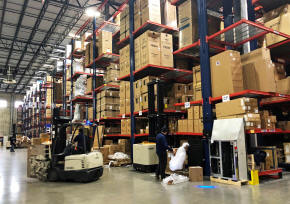Wait and see: U.S. companies curb investment as they
await Fed moves
 Send a link to a friend
Send a link to a friend
 [August 08, 2022] By
Timothy Aeppel [August 08, 2022] By
Timothy Aeppel
(Reuters) - Business investment appears to
be an early victim of red-hot U.S. inflation and rising interest rates.
Nonresidential fixed investment, which is how the Commerce Department
lumps together things like spending by businesses on new buildings and
renovations of existing ones, slipped 0.1% on an annualized basis in the
second quarter. This acted as a drag on gross domestic product, the
broadest measure of U.S. economic output. It also ended a seven-quarter
run of outsized additions to GDP that on average were more than double
the category's historic contributions to growth.
The cutbacks hit every industry except mining and drilling.
Economists are watching closely to see how inflation hits different
parts of the economy. Consumer spending has softened in the face of
higher prices but still added to growth in the second quarter.
Business investment stalled in the second quarter:
https://graphics.reuters.com/USA-ECONOMY/INVESTMENT/
jnvwenwewvw/chart.png
And even as companies curtailed adding new buildings and other
expansions, they kept hiring. U.S. job growth accelerated in July, and
the U.S. job market has now recovered to the level it was before the
pandemic. Meanwhile the stress on global supply chains eased last month
to its lowest level since January 2021, according to the New York
Federal Reserve.

The pullback in business spending "is more of a pause than a sign of
structural weakness," said Andrew Hunt, who heads the Center for Real
Estate at Marquette University in Milwaukee.
Hunt said a surge in rents and construction costs earlier this year -
part of a wave of price increases that have pushed inflation to a
four-decade high - caused some businesses to postpone adding new space.
But the pullback will be temporary, he predicts. He noted that demand
for space is so high and available space in such short supply that
vacancy rates are below 5% and in some markets there is essentially no
space available.
"People said, 'Letís see if the Fed does what they said they were going
to do - and see how things stabilize as we move into the fall.'"
The Fed has lifted interest rates at each of its meetings beginning in
March, including back-to-back outsized increases of three-quarters of a
percentage point at its last two policy gatherings.
Far-larger-than-expected payrolls gains for July, data for which was
issued on Friday, puts a third hike of that size squarely in play for
the next Fed meeting in September.
[to top of second column] |

Warehouse workers deal with inventory stacked up to the ceiling at
an ABT Electronics Facility in Glenview, Illinois, U.S. December 4,
2018. Picture taken December 4, 2018. REUTERS/Richa Naidu/File Photo

CBRE Group Inc., which tracks industrial property trends, also views the
pullback on business spending as temporary - and concentrated only in some
pockets of the industrial sector. The real estate company noted in a recent
report there was a record-breaking 626.6 million square feet of new industrial
construction underway nationally in the second quarter - nearly a third of which
was already leased.
"Last year was the biggest industrial leasing year ever - over 1 billion feet in
the U.S.," said John Morris, president of the logistics business for the
Americas at CBRE.
"This year looks like it wonít be quite as big," he said, noting they project
850 million square feet will be leased. That would still mark the second-biggest
year in their records.
Morris said the slowdown appears concentrated in smaller companies, rather than
the big-name e-commerce and retail firms that gain the most attention for their
investments in giant warehouses. Leasing of the biggest warehouses - those over
700,000 square feet - is up 25% in the first half of this year, compared to
2021, said Morris, while leasing of warehouses of 50,000 square feet or less is
off 21%.
"If you think about who typically is leasing those (smaller) buildings," it is
more likely to be smaller companies, he said, adding that those firms may be
more sensitive to costs like rising rents.
Craig Meyer, president of industrial for the Americas at Jones Lang LaSalle
Inc., said surging costs have curbed investments in industrial space. But he
remains optimistic.
"We talk to all our brokers about what will happen to the end of year. And all
of their pipelines seem to be solid," he said.
(Reporting by Timothy Aeppel; Editing by Dan Burns and Chizu Nomiyama)
[© 2022 Thomson Reuters. All rights
reserved.]
This material may not be published,
broadcast, rewritten or redistributed.
Thompson Reuters is solely responsible for this content.
 |